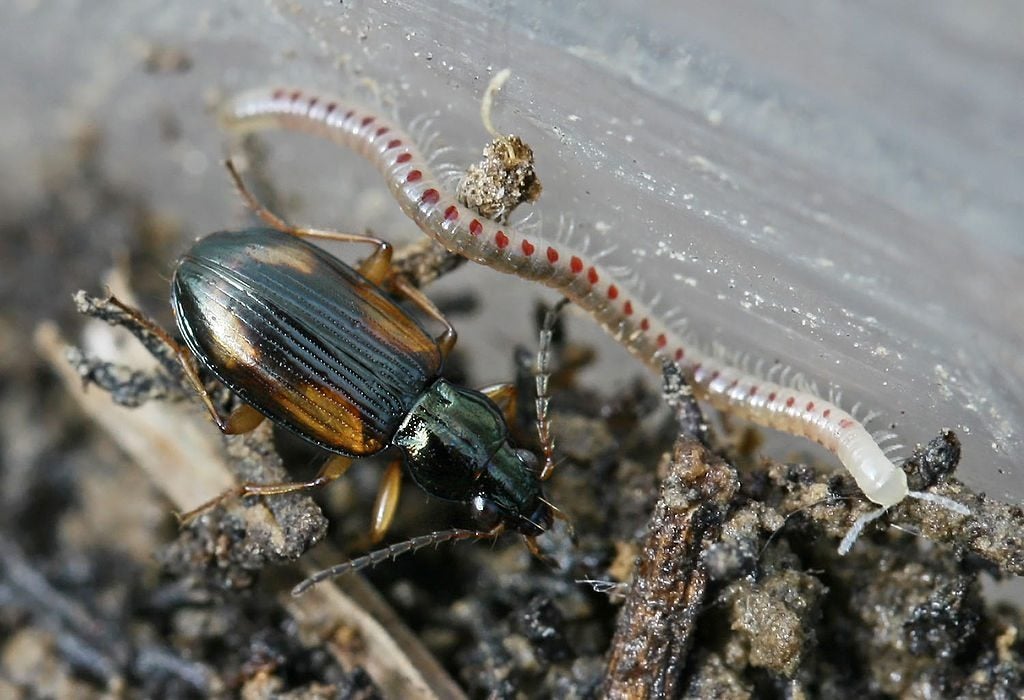Blaniulus Guttulatus Millipede Info – Learn About Spotted Snake Millipedes

I’m sure you’ve been out to the garden to harvest, weed, and hoe and noticed some slender insects with segmented bodies that look almost like tiny snakes. In fact, upon closer inspection, you notice the creatures have brownish to pinkish spots on the lateral sides of their bodies. You’re looking at spotted snake millipedes (Blaniulus guttulatus). What is a spotted snake millipede? Does Blaniulus guttulatus cause damage in gardens? If so, is there a spotted snake millipede control? The following article contains the answers to these questions and other Blaniulus guttulatus millipede info.
What is a Spotted Snake Millipede?
Spotted snake millipedes, along with centipedes, are members of a group of animals called myriapods. Centipedes are soil dwelling predatory animals that have only one pair of legs per body segment. Juvenile millipedes have three pairs of legs per body segment. Centipedes are more active than millipedes and, when discovered, make a run for it while millipedes either freeze in their tracks or curl up. Millipedes hide in the soil or under logs and stones during the day. At night, they come to the soil surface and sometimes climb up onto plants.
Blaniulus guttulatus Millipede Info
Spotted snake millipedes are a little over half an inch (1 cm.) in length, about the width of pencil lead. They lack eyes and have bodies that are pale white to cream in color with pinkish spots on their sides that represent defensive glands. These soil inhabitants feed on decaying plant material and lay their eggs in the soil during spring and summer, either singly or in small batches. The eggs hatch into miniature versions of the adults and can take several years before they reach maturity. During this period of adolescence, they will shed their skins 7 to 15 times and increase their length by adding additional segments to their bodies.
Blaniulus guttulatus Damage
While spotted snake millipedes primarily feed on decomposing organic matter, they can do damage to crops under certain conditions. During prolonged drought, this millipede may be attracted to crops to assuage their moisture needs. Infestation of spotted snake millipedes is often at its peak in soils rich in organic matter. Rainfall will also trigger an infestation. Blaniulus guttulatus can sometimes be found feeding inside bulbs, potato tubers, and other root veggies. They are usually following the path of least resistance, enlarging the damage already done by slugs or another pest or disease. Healthy plants are usually undamaged by millipedes due to their relatively weak mouthparts that are more suited to already decomposing matter. Garden crops that are susceptible to spotted snake millipede damage include:
Feeding damage at the roots can cause the rapid death of these plants.
Spotted Snake Millipede Control
Generally speaking, millipedes rarely cause any serious damage, so it isn’t necessary to control them with any chemical controls. Instead, practice good garden sanitation by removing crop residue and decaying plant material. Also, remove any old mulch or decomposing leaves that may harbor millipedes. Entomopathogenic nematodes are useful in managing millipede infestations. When strawberries are becoming damaged by millipedes, it’s probably because the fruit is resting on the soil. Place straw or hay around the plants to lift up the fruit. In the case of damage done to potatoes, the millipedes are probably just following the damage done by slugs, so steps should be taken to eliminate the slug problem. Chances are good that any minor millipede problem will sort itself out. Millipedes have many natural enemies such as birds, frogs, toads, hedgehogs, and ground beetles that are always searching for a tasty millipede morsel.
Gardening tips, videos, info and more delivered right to your inbox!
Sign up for the Gardening Know How newsletter today and receive a free copy of our e-book "How to Grow Delicious Tomatoes".

Amy Grant has been gardening for 30 years and writing for 15. A professional chef and caterer, Amy's area of expertise is culinary gardening.
-
 ‘Coral Charm’ Peony Care For Sublime Semi-Double Peonies With Lush Salmon Pink Flowers
‘Coral Charm’ Peony Care For Sublime Semi-Double Peonies With Lush Salmon Pink FlowersPeonies are known for their soft baby pink or magenta tones, but if plushy coral blooms are your thing, here’s our guide to the ultimate ‘Coral Charm’ peony care
By Tonya Barnett
-
 How To Grow Seeds Quickly: 8 Expert Tricks For Fast Flowers & Crops
How To Grow Seeds Quickly: 8 Expert Tricks For Fast Flowers & CropsIt's never too late to start growing! Jump-start your flower or vegetable garden with these pro tips and tricks for germinating seeds in record time.
By Amy Grant